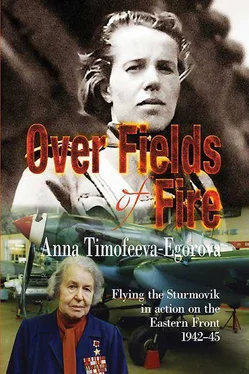To start with he advised that he had arrived from the Academy without graduating from it, and before that he had been Deputy Chief-of-Staff of the 366th High-speed Bomber Regiment. Before the war Yashkin had served as a junior commander, and had a Leningrad working-class background. His father used to work at the ‘Red Nailmaker’ plant and perished during the Blockade of Leningrad. Telling us about it Yashkin began to run the fingers of one hand through his unruly fair hair and wiped a tear off his cheek with the other… Leonid himself had been a worker at the ‘Red Nailmaker’ in the past, and his sister Anastasia was a medic at the front.
Getting up from the table Captain Yashkin pulled down his blouse as if shaking off the hard memories, straightened his belt and the loaded holster on it, put on a businesslike look and began his report: “Developing the advance in the South our troops have cleared the Soviet land of Fascist vermin. They have advanced hundreds of kilometres and liberated many areas of the North Caucasus, the Rostov District, part of the Ukraine and reached the Azov Sea… Their plans to capture the Caucasus oil and conquer the Black Sea coast and its ports have led the Hitlerites to complete destruction and a retreat from the North Caucasus in the direction of Rostov and the Taman Peninsula. Now, fearing a breakthrough of Soviet troops, the enemy has built a heavy defence line from Novorossisk to Temryuk. There are concrete pillboxes, dug-out weapon emplacements, anti-tank and anti-personnel fortifications, trenches with communication lines, dense landmine fields, a large amount of field and flak artillery. Because of the numerous water obstacles the Germans have called this strongly fortified position ‘The Blue Line’. According to their plan, it is supposed to cover their retreat to the Crimea.”
The Captain went on with his report but I became pensive… Suddenly I recalled Lermontov’s story Taman . I was fond of Lermontov 107 107 Editor’s note — M. Lermontov (1814-1841) is one of the most recognized Russian poets.
. Before the war Victor Koutov had presented me with a book of his verses, and currently it was striding with me down the roads of war…
“…In order to create a threat against their flanks”, the voice of the Chief-of-Staff was coming from somewhere distant, returning me to reality, “and to prevent the German Fleet using Tsemesskaya Bay, on the night of 4 February troops sent from Gelendzhik landed there. They captured a bridgehead called ‘Lesser Land’. The Germans have been trying all possible ways to annihilate the bridgehead. So, fighting doesn’t die down there day or night. Thus, we will be helping our landing party to wipe out the Fascist scum on the Taman Peninsula…”
Straining my memory I recalled our history teacher telling us that Taman was colonised by the Greeks a thousand and a half years ago, then settled by the Khazars, Mongols, Genoese, Turks… Suvorov had built a fort there. 108 108 Editor’s note — A. Suvorov (1729-1800) — a famed military commander of the pre-Napoleonic era.
“We have a mission. The squadron commanders are to stay for the briefing”, Regiment Commander Kozin entered the room with these words and unfolded a map on the desk.
We left the cramped quarters but stayed together, waiting for the decision: what if any of us went on a combat mission? “Maybe I will be included in the fighting group?”, I thought shyly. Everyone was excited — both novices and ‘oldies’, but tried to conceal it. Pilot Rzhevskiy told us a joke about a daughter who asked her father to tell her all he knew about steam engines, which had just come to existence. Her father talked a long time, showed her a picture, and then asked his daughter: “Well, do you understand everything?”
“Everything, Daddy! Just show me please, where they harness the horses…” The airmen laughed. A short brawny fellow from Rybinsk, Volodya Sokolov ran up to me and, putting on a serious face with difficulty, said:
“Anyuta, let’s swap heights!”
“Let’s do it, Volodya. I love high-heeled shoes so much but feel shy of wearing them because of being tall. But how shall we do it? And what will I get for the difference — after all I am 170 centimetres tall and you’re only 160?”
“Sokolov, Egorova, Vakhramov, Tasets, Rzevskiy, up to the commanders!” This was an order from the Chief-of-Staff. Everyone forgot all about jokes and ran into the dugout.
We were proffered not a straight flight route but a kind of zigzag one. “We’ll avoid the enemy’s flak guns. It’ll be better that way. Stay in the formation, do what I do”, the navigator Karev, our leader, said and showed us on the map who was to fly where. My position was wingman to the right of Petr Karev.
What I was thinking about before my first combat sortie in a Sturmovik , it’s hard to say. There was no fear. There was a kind of satisfaction: look, they’ve included me in the first flight group, now I must not disgrace myself — after all, I am the only woman amongst so many men, and what men — Sturmovik pilots!
A quartet of LaGG-3s from a fraternal fighter regiment based on the same aerodrome as we were, was to escort us. There were five regiments in our 230th Ground Attack Aviation Division: four ground-attack and one of fighters. The Division was under the command of a Hero of the Soviet Union Colonel Semyon Grigorievich Getman.
Here we were sitting in the cockpits of our combat planes and waiting for the signal — a green flare. My eyes slid over the instruments, my fingers ran over (as if to get the feel of them) the numerous switches and handles — I was checking the correct setting of their positions. My mechanic Rumskiy was here, next to the plane. He had made the plane ready for a combat sortie long before but now he wipes clean the long ago cleansed and shiny reinforced glass of the cockpit, then sets straight a parachute strap on my shoulder and looks at me as if to ask: “What else can I do for you?..”
“Thanks, friend. I need to be alone for a little while and concentrate, to collect my thoughts”, I thanked my mechanic, and looked at Karev’s Sturmovik standing ahead of me to the left. The group leader was quiet. He put his hand on the cockpit sides and seemed to be singing. “Doesn’t the coming mission really worry him in the least?” I thought with astonishment. But my thoughts were interrupted by a green flare soaring above the Command Post. Hissing nastily it rose above the field and began to fall very slowly and burn out. Time we take off! Our course — to ‘Lesser Land’.
During the flight I did my best to stick close to Karev: I was afraid of falling behind. Here was our target. The leader swung his plane in a manoeuvre — I did the same, he dived almost to the very ground — so did I, he shot — I shot too. I dropped my bombs after him as well. But after the fourth pass on the target I fell behind nevertheless. And I didn’t just fall behind but lost the whole group. What should I do now? Now I was flying on my own among dense shell bursts. I manoeuvred desperately, looked for the group but didn’t see it… Near Myskhako I turned onto our territory and became a witness to dozens of our planes and the enemy’s fighting an aerial battle over Tsemesskaya Bay. Fighter planes were falling into the sea, pilots were descending on parachutes, motorboats were rushing towards them from both sides. I was observing such a battle for the first time in my life…
It was not easy for a novice to make sense of the melee taking place over the Taman Peninsula. Two fighters dashed towards me like black vultures. For some reason I took them for our ‘Yaks’ but when a machine-gun tracer passed ahead of me to the right and they began to turn for a second pass I clearly saw white crosses on their fuselages. The Germans behaved extremely insolently, taking no care for their own defence, and attacked from different directions but without result. The Sturmovik ’s speed was lower than the Messerschmitt’s, and during one of their attacks they skipped forward and appeared in my gun-sight. I pressed all the triggers simultaneously but, alas, no discharge followed: all my ammunition had been spent over the target. That time I was saved by our fighters. They drove the Fascist vultures away from my plane and even shot one down — and so I made it home safely.
Читать дальше












